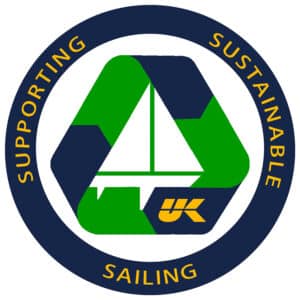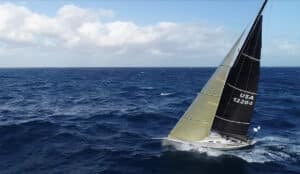PHOTO 1. Sheeting the trysail with sheets led to the spinnaker blocks on the after quarter.
The day before racing started at Key West Race Week, the wind blew 30 knots, which kept crews ashore – all except for one. I sailed on Joe Mele’s Swan 44 Mk II TRIPLE LINDY and we decided to go out and practice with our storm sails that day. Our practice was an integral part of the boat’s program since later this year the boat will race the Bermuda Race and then be shipped to Australia for the Sydney Hobart Race. It is nearly a given that as some point in that race the wind will blow hard enough requiring storm sails to be flown.
We learned a good lesson about how to rig and trim the storm trysail that we never learned in previous light air practices. We trimmed the storm trysail in both recommended ways to see which worked best. First we used two sheets, each led to the spinnaker sheet blocks on the aft quarter. This is the traditional set up (Photo 1). In 30 knots of wind we found that when the sail luffed, the lazy sheet, rigged over the boom, whipped around violently at head and should height, which was dangerous to those in the cockpit.
We then transferred the trysail’s clew to a reef line and then trimmed the sail off the boom with the mainsheet. This worked out much better and was much safer (Photo 2).
Thus we learned two things that day. The first was which is better to trim the trysail and the second was that practicing with storm sails in heavy air is much different than practicing in light air.
PHOTO 2: Here the trysail is clew is secured to the boom with a reef line and then stropped to the boom with a separate line. With the sail attached to the boom, it can be trimmed with the mainsheet. Sailing TRIPLE LINDY in 30 knots of wind the day before racing started at Key West Race Week, we discovered this method was safer since there are no sheets shaking violently across the cockpit.




Why is the tack cut so short on a storm trysail?
Why is the tack cut so short on a storm trysail?
I would like to have seen this done with the main in place and the tri on a separate track.
I have talked to many riggers about doing this. I single hand a 34′ Pearson and love bid wind!
I would like to have seen this done with the main in place and the tri on a separate track.
I have talked to many riggers about doing this. I single hand a 34′ Pearson and love bid wind!
interesting! useful tips and very clear photos on how to use it. …… best to Know, even it will never be the case to use them. 😉
Agree with G.W.
I’ve single-handed my Pilot 35 to Bermuda in 6 of the 1-2’s and frequently seen 30+. Only once or twice have I even had to use the 3rd reef.
BUT, getting the main off is hard time-consuming work on a calm day on the mooring. No way could I do it in conditions that would require thinking about a trysail or even a second reef.
I do have a separate trysail track…so it would be nice to think about doing it with the main secured to the boom. Might be too much chafe, though.
In my practice set-ups I use a single sheet. I figure I’ll pretty much be hove-to by that time, and I set up for the tack I want to be on (starboard for the rights, if conditions allow).
Agree with G.W.
I’ve single-handed my Pilot 35 to Bermuda in 6 of the 1-2’s and frequently seen 30+. Only once or twice have I even had to use the 3rd reef.
BUT, getting the main off is hard time-consuming work on a calm day on the mooring. No way could I do it in conditions that would require thinking about a trysail or even a second reef.
I do have a separate trysail track…so it would be nice to think about doing it with the main secured to the boom. Might be too much chafe, though.
In my practice set-ups I use a single sheet. I figure I’ll pretty much be hove-to by that time, and I set up for the tack I want to be on (starboard for the rights, if conditions allow).